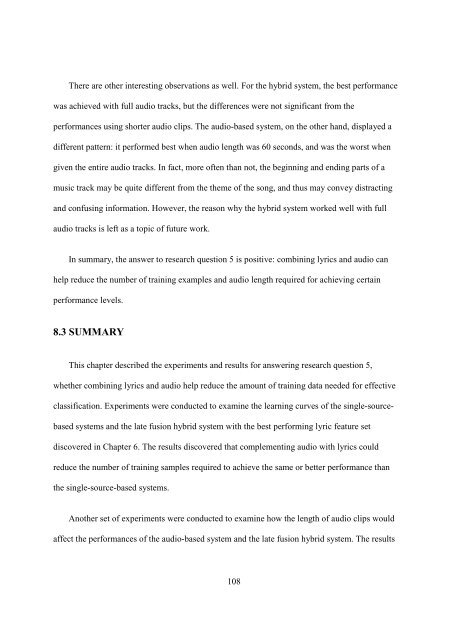improving music mood classification using lyrics, audio and social tags
improving music mood classification using lyrics, audio and social tags
improving music mood classification using lyrics, audio and social tags
You also want an ePaper? Increase the reach of your titles
YUMPU automatically turns print PDFs into web optimized ePapers that Google loves.
There are other interesting observations as well. For the hybrid system, the best performance<br />
was achieved with full <strong>audio</strong> tracks, but the differences were not significant from the<br />
performances <strong>using</strong> shorter <strong>audio</strong> clips. The <strong>audio</strong>-based system, on the other h<strong>and</strong>, displayed a<br />
different pattern: it performed best when <strong>audio</strong> length was 60 seconds, <strong>and</strong> was the worst when<br />
given the entire <strong>audio</strong> tracks. In fact, more often than not, the beginning <strong>and</strong> ending parts of a<br />
<strong>music</strong> track may be quite different from the theme of the song, <strong>and</strong> thus may convey distracting<br />
<strong>and</strong> conf<strong>using</strong> information. However, the reason why the hybrid system worked well with full<br />
<strong>audio</strong> tracks is left as a topic of future work.<br />
In summary, the answer to research question 5 is positive: combining <strong>lyrics</strong> <strong>and</strong> <strong>audio</strong> can<br />
help reduce the number of training examples <strong>and</strong> <strong>audio</strong> length required for achieving certain<br />
performance levels.<br />
8.3 SUMMARY<br />
This chapter described the experiments <strong>and</strong> results for answering research question 5,<br />
whether combining <strong>lyrics</strong> <strong>and</strong> <strong>audio</strong> help reduce the amount of training data needed for effective<br />
<strong>classification</strong>. Experiments were conducted to examine the learning curves of the single-sourcebased<br />
systems <strong>and</strong> the late fusion hybrid system with the best performing lyric feature set<br />
discovered in Chapter 6. The results discovered that complementing <strong>audio</strong> with <strong>lyrics</strong> could<br />
reduce the number of training samples required to achieve the same or better performance than<br />
the single-source-based systems.<br />
Another set of experiments were conducted to examine how the length of <strong>audio</strong> clips would<br />
affect the performances of the <strong>audio</strong>-based system <strong>and</strong> the late fusion hybrid system. The results<br />
108
















